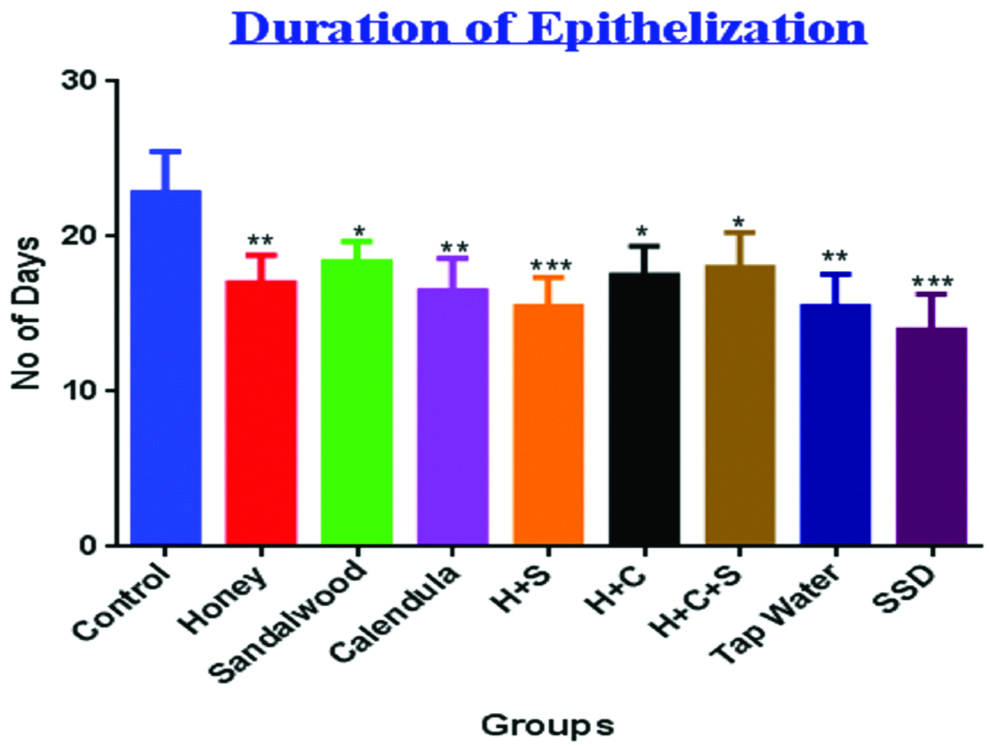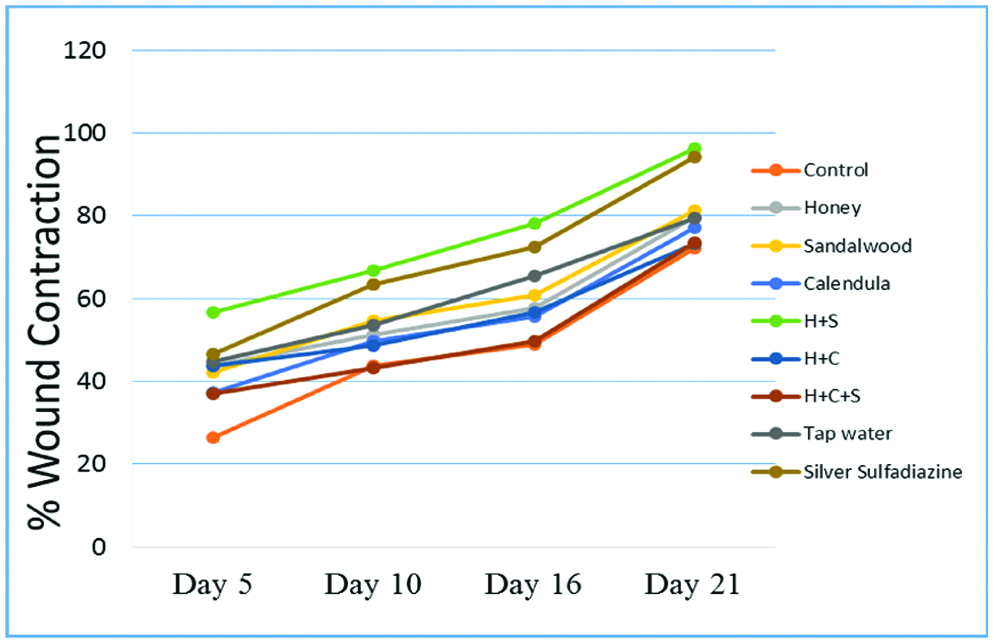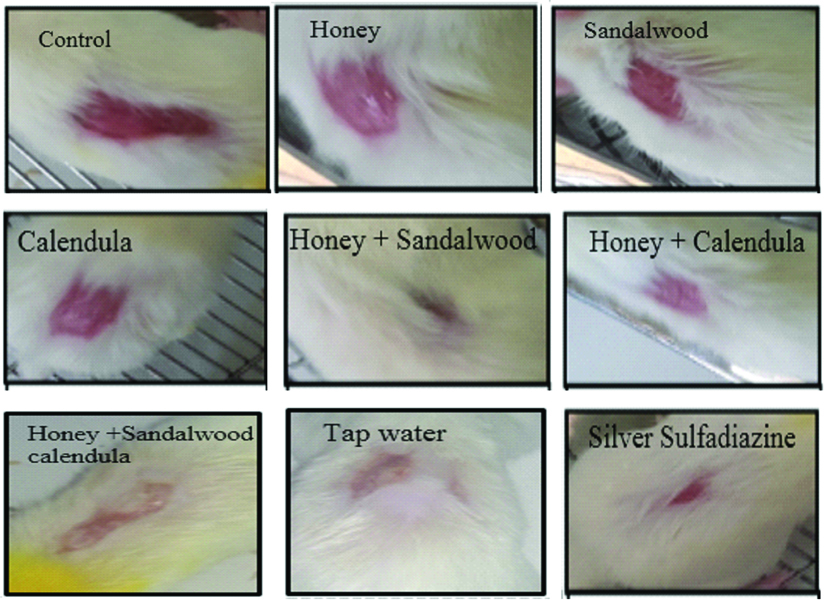Burns remains a major public health issue because of morbidity and mortality associated with it [1]. It may lead to complications like long-term disability, prolonged hospitalisation, loss of extremities and even death [2]. Burn wound healing is a complicated process including inflammation, re-epithelialisation, granulation, neovascularisation and wound contraction [3]. Healing of burn wounds still remains a challenge to modern medicine, though many antiseptics have been discovered. Antimicrobial ointments such as silver sulfadiazine, mafenide, silver nitrate, povidone-iodine, mupirocin and bacitracin, are used to reduce the risk of infection. These topical antimicrobials have some side effects and are only partially effective [4]. Silver sulfadiazine (SSD) cream at 1% is the most widely used for burn injury [5]. The high anti-microbial efficacy of SSD is probably the main reason for its widespread use. Several adverse reactions have been reported, such as resistance to silver sulfadiazine, renal toxicity, and leukopenia therefore the topical cream should not be used for long periods [6]. Honey is a reasonable dressing material in developing countries because of its easy availability and it being economical too. Baghel PS et al., showed that honey dressing improved wound healing in lesser time and prevented scarring and post-burn contractures in comparison with SSD dressing [7]. Sandal wood (Santalum album) paste has cooling effect and has been used in skin ailments as a traditional medicine. In the study of Hussain T et al., Santalum album showed maximum antibacterial activity [8]. Calendula officinalis flower extract has antioxidant, anti-inflammatory, antibacterial, antifungal, antiviral activity as well as angiogenic action [9,10]. All these activities have been attributed to its active components viz., triterpenoids, faradiol monoester. First aid guidelines of cold tap water (approximately 15°C) for 20 minutes are beneficial in helping to heal the burn wound [11]. Present study aimed for Comparative study of burn wound healing potential of Honey, Sandal wood (Chandan) paste, Calendula ointment and cooling of wound with tap water.
Materials and Methods
The experimental study was carried out in the department of Pharmacology, Bharati Vidyapeeth Deemed University Medical College, Pune from April-September 2016. Standard preparations of honey and sandalwood powder were obtained from the local market Ayurvedic shop and authenticated in Bharati Ayurved college and calendula ointment from pharmacy. Sandal wood paste-was prepared by mixing sandalwood powder with distilled water.
Ethical committee approval was taken prior to commencement of this study (BVDUMC/3297/2016/011/002).
Animals: Wistar rats of either sex weighing 180 to 200 grams were used for the study. They were housed under standard conditions at room temperature and given food and water, ad libitum throughout the study.
Induction of burn injury: Rats were anaesthetised with intraperitoneal thiopentone sodium injection (40 mg/kg body weight). Back of the rats were shaved, 24 hours before exposure to thermal stimuli. Thereafter anaesthetised rats were placed in supine position in hot water (90°C) for 6 seconds which lead to second-degree burn on the back of the skin. In this experiment, approximately 10% of Total Body Surface (TBSA) was burned. The animals were then resuscitated with an intra-peritoneal injection of 5 mL of normal saline solution.
Groups: The animals were randomised into nine groups (n=6/group):
Group 1 Control group (no topical agent applied);
Group 2 Treated with honey;
Group 3 Treated with sandal wood paste;
Group 4 Treated with calendula ointment;
Group 5 Treated with honey and sandal wood paste;
Group 6 Treated with honey and calendula Ointment;
Group 7 Treated with honey and sandalwood and calendula (H+C+S);
Group 8 Cooling with tap water;
Group 9 Treated with 1% SSD (silver sulfadiazine).
Treatment began immediately after the burn injury; Group eight received first aid of cooling with tap water whereas other rats received drugs corresponding to the group. Treatment was given twice daily till complete wound healing was achieved. Cooling was done by firmly placing tap water (14.95°c) soaked gauze swabs on the wounds and the swabs were changed every 3 minute till 1 hour [11].
Wound contraction: In order to quantify the rate of wound healing, the size of lesions was measured at 0,5,10, 16 and 21 days after burn injury. By holding the animals in a good position, the wound margin was traced on a transparent plastic sheet using a fine-tipped pen and the tracing was then transferred to 1 mm2 graph sheet, from which the wound surface area was evaluated. The evaluated surface area was then employed to calculate the percentage of wound contraction. The area of the wound on day Zero was considered as 100% and wound area on subsequent days was compared with the wound area on the initial day. Wound contraction was expressed as reduction in percentage of the original wound size. It was calculated by using formula:

Epithelialisation period: It was monitored by noting the number of days required for the scar to fall off from the burn wound surface without leaving a raw wound behind. The period required for epithelialisation was calculated as the number of days required for falling of the dead tissue remnants without any residual raw wound.
Statistical Analysis
Statistical analysis was done with Graph pad prism 6. ANOVA followed by post hoc test was used for Statistical significance. A p-value less than 0.05 was considered as statically significant.
Results
Duration of Epithelisation
Epithelisation was very rapid in honey and sandalwood combination group [Table/Fig-1]. It was gradually observed in the individual drug treated groups over a period 21 days. Wounds of control group were partially healed and with incomplete scarring.
Duration of epithelisation.
Values are expressed as Mean±SEM
*p<0.05, **p<0.01, ***p<0.001 in comparison with control

Wound contraction started very early in the honey and sandalwood group. Percentage of wound contraction was significantly (p<0.001) [Table/Fig-2] more than the all other drug treated groups and complete closure with normal hair growth was seen by the end of 21 day [Table/Fig-3].
Percentage of wound contraction after topical drug treatment.
| Group (n=6) | Day 5 | Day 10 | Day 16 | Day 21 |
|---|
| Control | 26.33±3.00 | 43.83±1.97 | 48.83±2.18 | 72.16±1.81 |
| Honey | 43.83±2.79** | 51.33±2.41 | 57.66±2.65 | 79.83±4.84 |
| Sandalwood | 42.16±3.81* | 54.66±3.37 | 60.83±3.03 | 81.33±2.99 |
| Calendula | 37.33±2.20 | 49.83±2.77 | 55.66±4.37 | 77.13±1.97 |
| H+S | 56.66±1.66*** | 66.83±2.50** | 78.11±3.53*** | 96.16±1.60*** |
| H+C | 43.66±2.96** | 48.66±2.98 | 56.66±3.35 | 73.23±3.63 |
| H+C+S | 37.16±1.30 | 43.16±2.38 | 49.83±1.79 | 73.51±3.26 |
| Tap water | 44.83±1.92** | 53.66±3.13 | 65.51±3.58* | 79.5±3.68 |
| Silver Sulfadiazine | 46.51±3.49** | 63.33±2.60** | 72.51±2.59*** | 94.16±2.32*** |
Values are expressed as Mean±SEM
*p<0.05, **p<0.01, ***p<0.001 in comparison with control
Percentage of wound contraction after topical drug treatment.

In combination therapy, Honey+Sandalwood showed improved wound contraction which was comparable to silver sulfadiazine and the efficacy was maintained throughout the experiment. This combination was more effective than the silver sulfadiazine. In case of single drug treatment, wound contraction was increased in Honey and Sandalwood group from 5th day in comparison to control and the results of both the groups were comparable to each other but were less than silver sulfadiazine. Individual agents honey, calendula and tap water were also significantly (p<0.01) effective in promoting the wound contracture than the control group. First Aid Group with Tap water [Table/Fig-3] showed considerable improvement on 5th day and was comparable to single drug treatment with individual drugs. Tap water treatment was less effective than H+S combination group. Honey+Calendula combination showed no apparent benefit of combination. Silver sulfadiazine showed comparable efficacy to individual agent but was less effective than the combination of Honey and sandalwood combination treatment [Table/Fig-3,4].
Images of Wound contraction on day 21.

Discussion
Cooling with tap water as first aid showed better results when compared to control group and the healing potential was comparable to single drug treatment viz., honey and sandalwood. Study conducted by Jandera V et al., on pigs showed similar result i.e., cooling with water displayed rapid healing as compared to untreated controls [11]. Cooling with tap water tends to act by reducing heat at the site of injury and this helps in containing the tissue damage whereas another action attributed to cooling with tap water is vasoconstriction which helps in reducing the edema. Reduced inflammation is seen as there is decreased release of pro-inflammatory factors viz., histamine, prostaglandins. All these effects are beneficial for accelerated wound healing in case of burn injuries.
Honey as an individual agent showed rapid wound healing; as compared to control group but its therapeutic effect was less than that of silver sulfadiazine which was positive control in this study. Subrahmanyam M et al., compared topical honey and silver sulfadiazine in human patients and found that honey showed better efficacy than silver sulfadiazine at the end of 21 days of treatment [12]. Honey is beneficial as it exerts antimicrobial action which can be attributed to following factors: i) low pH (3.6); ii) presence of thermolabile substance called inhibine; iii) hyperosmolar characteristic which prevents bacterial growth [13]. Antibacterial effect was more prominent when honey was used in diluted form by addition of water, since addition of water leads to production of hydrogen peroxide [14]. In present study undiluted honey was used for dressing. Honey also helps in maintaining moist environment as it forms a physical barrier due to its high viscosity as well as it promotes de-sloughing and cleansing of wounds [15].
To the best of our knowledge, no studies have been conducted to see the effect of sandalwood in burn injuries. In this study efficacy of sandalwood was comparable to that of honey but less effective in comparison to silver sulfadiazine. Traditionally sandalwood has been used topically for its cooling effect [16]. Case studies published by Ghatnekar AV et al., showed that formulation prepared from mixture of Calendula officinalis and Santalum album showed good results on wound healing [17]. Some studies have also attributed antimicrobial action to different formulations of sandalwood [18-21]. The fragrant parts of sandalwood oil constitutes of α- and β santalols. Sandal wood is useful as antiviral, antifungal, antioxidant, anti-inflammatory, antipyretic and it also has sedative effect by its central action [16]. It has moisturising properties, it is a mild astringent and antiseptic [22]. Cooling and antimicrobial action may be responsible for the therapeutic efficacy of sandalwood after topical application in the form of paste.
Calendula as individual agent showed decreased efficacy in comparison to honey and calendula. Limited number of studies has evaluated wound healing potential of calendula and in one such study calendula was found to promote epithelialisation in incised wounds of rats [23,24]. In a clinical trial conducted by, calendula was applied topically in burn wounds and it was found to be effective. Calendula officinalis reduced inflammation and faster epithelialisation [25].
All these agents tend to reduce inflammatory component of burn wound pathogenesis, hence rate of wound healing during the initial days (<10 days) of treatment was faster as compared to thereafter.
Honey has been studied as a wound dressing for various types of wound. Sandalwood has not been studied for burn wound. Both of them have antibacterial activity which rapidly clears infection, they also rapidly debride wounds and removes malodour [26]. Anti-inflammatory activity of both the ingredients reduces oedema and exudate, and prevents or minimises hypertrophic scarring. Honey provides a moist healing environment without the risk of bacterial growth occurring and sandalwood has moisturising, astringent and antiseptic property [27]. Honey also stimulates the growth of granulation tissue and epithelial tissue so that healing is hastened. Wound healing process consists of inflammation, reepithelialisation, granulation and neovascularisation, which result in wound contraction.
Therefore, combination therapy, honey plus sandalwood therapy may have showed synergistic effect which may be due different mechanism of actions exerted by these individual agents. In case of honey plus calendula therapy the activity was equivalent to sole effect of honey indicating no additional benefit of the combination.
Limitation
Histopathological study of the lesions was not performed.
Conclusion
Cooling with tap water was found to be effective as a first aid in the present study. Honey, sandalwood and calendula as individual agents are effective but less as compared to silver sulfadiazine. Honey plus sandalwood combination was the best among all the combination therapy and this combination showed better efficacy than silver sulfadiazine.